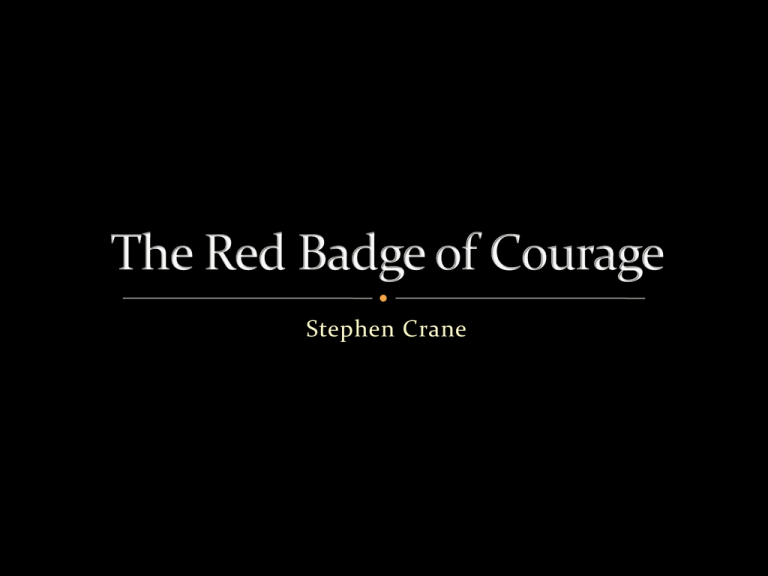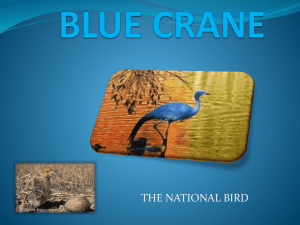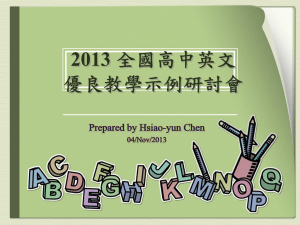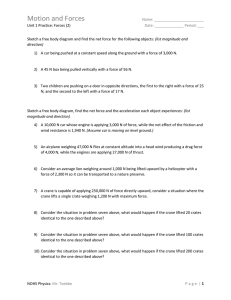The Red Badge of Courage
advertisement

Stephen Crane Stephen Crane 1871-1900 The Red Badge of Courage is one of the first modern American novels. The events in this famous novel take place during the American Civil War, probably at the Battle of Chancellorsville, which was fought in May, 1863. The episodic plot revolves around a young Union soldier’s anxiety as he confronts his first battle and explores larger themes of fear and bravery, patriotism, and brotherhood. The Battle of Chancellorsville, which is in northern Virginia During the 1860’s, conventional beliefs held that a young man’s character was best tested in war. The battlefield demanded patriotism, bravery, obedience, and faith in a particular cause. Crane explored the theme of character development as a result of war experiences, but he treated the theme critically, using the methods of realism and naturalism. The Civil War formally began on April 12, 1861 President Lincoln issued a call for volunteers to defend the Union and abolish slavery Each day, newspapers throughout the North and South were filled with the exciting details of the battles Union and Confederate forces were unprepared for a long war; the armies were poorly trained, and discipline was weak About one million men were wounded, and more than 500,000 died, either from battle wounds or disease After the Civil War, the nation’s main concern was the expansion of commerce and industry New scientific views of the world began to undermine traditional religious views Many American writers found in realism the best way to explain these changing conditions Romanticism had idealized the imagination, but realism emphasized the dispassionate observation of fact The rise of naturalism corresponded with the increasing industrialization of society Naturalism contended that human beings are helpless creatures passively influenced by heredity, environment, and the cruel forces of nature Naturalist writers focused on the sordid, painful, and tragic aspects of the human experience Stephen Crane’s work contains elements of both realism and naturalism. Crane did not just want to depict reality as it was; he also wanted to present a personal vision of the world. The Red Badge of Courage combines observant reporting of details with the revelation of the forces at work within and around the novel’s protagonist, Henry Fleming. Crane was born in 1871 in Newark, New Jersey He was an introspective, rebellious young man who thirsted for adventure in spite of frequent illness Though he died at the age of 28, Crane left behind novels, stories, and poems that secured his place in the history of American literature Crane was the youngest of fourteen children He was fascinated by the military record of his family and entered a military school in New York when he was 17 Crane excelled in military drill and greedily absorbed stories about military battles as described by Civil War veterans who taught at the school Crane lived among the poor in New York City, and from this experience he wrote his first novel, and the first American naturalist novel, Maggie: A Girl of the Streets, in 1893 Though later considered a solid novel critically, because of its controversial topic, it was a financial failure at the time Originally published serially in the Philadelphia Press in December, 1894, the novel was widely praised both by the general public and by literary critics Crane had long been fascinated by the psychology of war; he had read books, listened to many stories by veterans of the Civil War, and studied closely the war photographs of Matthew Brady Many readers are amazed to learn that Crane did not experience a battle firsthand until four years after the novel was published When he did, he was relieved to discover that his novel was “all right” President Lincoln sits for an official photograph by Matthew Brady The Red Badge of Courage brought Crane only ninety dollars, but his fame spread He traveled in the American West and Mexico; he smuggled arms to Cuban revolutionaries, and he was shipwrecked off the Florida coast, which would prove to be the inspiration for The Open Boat, considered his masterpiece Crane tried to enlist in the United States Navy but was rejected because of poor health; he did cover the war as a correspondent Crane died in 1900 of tuberculosis, six months before his 29th birthday Crane with his wife, Cora, in 1899, just months before his death The Red Badge of Courage made a startling impression on its first readers, for there were no other books of its kind The novel showed great originality, especially in its treatment of character and its sparse, poetic language Other important characteristics of the novel are the use of realistic and naturalistic details and the exploration of themes of universal concern Crane’s writing is spare and compressed, and he uses a relatively simple vocabulary Crane gives little attention to characterization of individuals, and the novel’s important characters are initially identified as “the youth,” “the loud soldier,” and “the tall soldier” Crane concentrates on the thoughts and impressions of Henry Fleming, describing the self-doubt, guild, sense of isolation, and terror Crane was a realist in his determination to write honestly about life as he saw it Crane saw nature as indifferent to human beings and viewed individuals as a mixture of good and bad qualities Crane used details that illustrate the senselessness and brutality of war, the horror of death, and human weaknesses such as false pride and selfishness Crane did not glorify heroism in battle Like the naturalists, Crane focused on the sordid details of life and on characters who are shaped by their heredity and environment Henry Fleming struggles with indifferent natural and social forces over which he has no control Despite Henry’s inability to escape his situation, Crane suggests that the outcome of this struggle can be courage and self-respect Henry Fleming picks up the American flag before it touches the ground The novel deals with the inner conflicts of Henry Fleming, but it is not altogether a character study The novel is one writer’s effort to address certain significant questions that, sooner or later, all human beings must ask themselves Five questions are of paramount importance in the novel: How do people act when faced with adversity, danger, and death? How do we cope with feelings of inferiority, fear, guilt, loneliness, and anger? What is our responsibility to other beings? Are the forces of nature sympathetic, hostile, or indifferent to us? Who or what determines our fates? What control do we have over our own destinies? Chapters 1-7 Chapters 8-11 Chapters 12-18 Chapters 19-25





